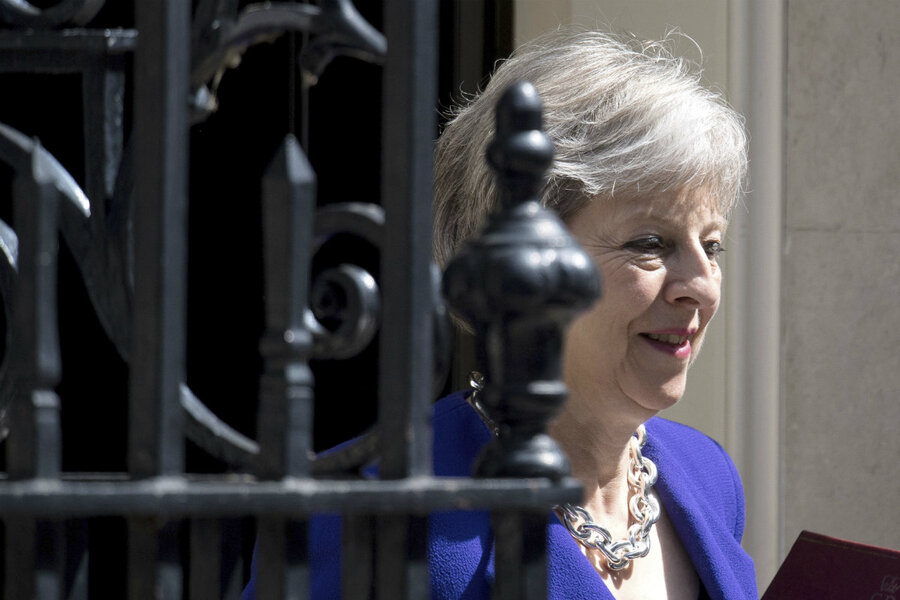Theresa May tries to unite fractious ministers on Brexit trade plan
Loading...
| London
British Prime Minister Theresa May faced resistance and potential rebellion from hard-core Brexit backers in her Conservative government Friday as she gathered her fractious Cabinet to hammer out a plan for future trade with the European Union.
Almost 30 Cabinet ministers were being sequestered inside the prime minister's Chequers country retreat northwest of London – without their phones – for all-day talks on a compromise plan that Ms. May hopes will unite the government, and be accepted by the bloc.
It's a tall order.
With just nine months to go until Britain leaves the bloc, May said the government has "a great opportunity – and a duty" to agree upon a plan. But pro-Brexit ministers including Foreign Secretary Boris Johnson have doubts about her proposal, which would see Britain stick closely to EU rules for trade in goods.
Brexit-backing ministers believe that would limit Britain's ability to strike new trade deals with the United States and other countries around the world. A more pro-EU group that includes Treasury chief Philip Hammond thinks it's essential to retain close economic ties with the bloc and its market of 500 million people.
That view has been echoed by big manufacturers including Airbus and Jaguar Land Rover, who warn they could abandon Britain if the EU and the Britain cannot strike a strong free trade deal. Airbus alone employs some 14,000 workers in Britain.
Airbus chief executive Tom Enders slammed Britain's divided government Friday, saying "Her Majesty's government still has no clue, or at least no consensus, on how to execute Brexit without severe harm."
Leading Cabinet Brexiteers, including Johnson and Brexit Secretary David Davis, met in private Thursday, sparking rumors some could quit if May does not alter her 120-page proposal.
British media reported that Cabinet ministers have been warned that if they resign, they would immediately lose their government cars and have to call a taxi to leave Chequers.
But Cabinet Office Minister David Lidington, May's second-in-command, was optimistic that a consensus would be reached in Friday's talks, expected to last for 12 hours at the 16th-century manor house 40 miles northwest of London.
"I think at the end of the day we'll get to an agreement and we'll have an offer to put to our European colleagues," he said.
As the British government bickers, EU leaders have grown impatient, warning May that she must present concrete and "realistic" proposals within weeks if there is to be a deal by the time Britain leaves on March 29, 2019.
The bloc has repeatedly warned Britain that it cannot "cherry pick" the benefits of EU membership, such as access to the customs union and single market, without accepting the responsibilities, which include allowing the free movement of EU citizens to Britain.
EU Brexit negotiator Michel Barnier stressed Friday that Britain can't treat the single market as a "big supermarket."
The EU is also demanding certainty on the future of the border between the UK's Northern Ireland and the Republic of Ireland – the United Kingdom's only land frontier with an EU member.
Britain has promised to maintain an invisible border, free of customs posts and other infrastructure. But the government has not said how that could be achieved given May's insistence that Britain will leave the EU's customs union.
The proposal May was presenting Friday – dubbed a "facilitated customs arrangement" – calls for Britain to use technology at the border to determine whether goods are bound for Britain or the EU, and to charge the appropriate tariffs.
It would also commit Britain to keep its regulations closely aligned to those of the EU for trade in goods and agricultural productions – but not in services, which accounts for the bulk of Britain's economy.
Speaking in Brussels, Mr. Barnier appealed for a compromise. He said the EU was willing to adapt its offer if Britain moved the "red lines" that rule out customs union or single market membership.
"Our objective has always been to find an agreement with the UK, not against the UK," he said.
"Time is short. We need to quickly have realistic and workable solutions," Barnier added.
This story was reported by The Associated Press.







